Shimano R9150 RD - Why so few direct mount hangers?
Moderator: robbosmans
Colnago,
I took another look at my bike with the B link this morning. Since the B link is responsible for how far back the RD can pivot, rotating the B link to the correct position will allow the RD to pivot further back, thus aiding wheel removal. Please give that a try and report back your findings. You may have to readjust the B screw (counter-clock wise) to move the upper pulley wheel forward after changing the B link position.
I took another look at my bike with the B link this morning. Since the B link is responsible for how far back the RD can pivot, rotating the B link to the correct position will allow the RD to pivot further back, thus aiding wheel removal. Please give that a try and report back your findings. You may have to readjust the B screw (counter-clock wise) to move the upper pulley wheel forward after changing the B link position.

Visit starbike.com Online Retailer for HighEnd cycling components
Great Prices ✓ Broad Selection ✓ Worldwide Delivery ✓
www.starbike.com
pdlpsher1 wrote: ↑Wed Jan 24, 2018 8:30 amColnago,
Thanks for taking the time to take these pictures. I analyzed the pictures and also played with my RD. I have discovered several things. Firstly, I noticed something right away with your first picture. I can see the B link is mounted incorrectly. There are two raised tabs on the B link. Both of these tabs needs to be above the little hook on the hanger. I found Shimano'a manual that shows a picture of how it should be installed. I don't know why there are two tabs and not just one. It seems the upper tab is redundant. Shimano's manual doesn't discuss the difference between the two tabs. Perhaps the upper tab is there to keep the B link from moving in the other direction. If you raise the B link per the picture shown in the manual then the RD will be positioned much further back. This could affect how far back the upper pulley wheel can be pushed back. Secondly, you are correct that the B screw has not effect on how far back the pulley wheel can go. The B screw does move the pulley wheel forward and I had thought it also controls how far back it goes. I apologize for the mistake. Thirdly, I saw your pic on Porte's BMC bike. I backed out my B screw and it did move the pulley wheel forward. I can only go so far before the pulley wheel interferes with the largest cog (34). I took a picture of the RD in the small-small gear combo. Because I'm running a 11-34 cassette, perhaps my B screw will be different than that of Porte's bike. Additionally, my hanger seems to put the RD much further back than on Porte's bike. Again I have the MTB hanger and perhaps the road version has a different geometry. I will ride the bike with the new B screw adjustment. Prior to the changes I had no shifting issues. And I expect I won't have shift issues with the new setting. Shimano's system seems to be very immune to setting changes.
Please change the B link position on your friend's bike and report back on how that affects the RD's position and how far back the pulley wheel can go. And I will report back any changes in shifting performance with the revised B screw setting. Thanks.
Oh my... ok @pdlpsher1, at this point I am just going to use you as my "straight man", for the benefit of others to learn from.
I didn't have to change the b-link per your request to know it was already installed correctly. And I already knew what would happen if I did and how it would look. You should have instantly been able to recognize that as well, I don't know how anyone who has worked with this stuff for any amount of time could have possibly come to the conclusion that it was mounted to the hanger incorrectly... but anyway, to humor you...
Here is the backside of the hanger clearly showing how it is installed. It is installed correctly, and you should have been able to tell that from a quick glance...
The backside...

Why do I say you should have been able to tell that from an instant glance or otherwise know at least that much was correct? Because if you've played with this stuff you'd know what it looks like if you do install it with the hanger stop in between those two pieces on B-link. It looks like this... and note the floppy chain. Yes, it is still on the front chain ring...
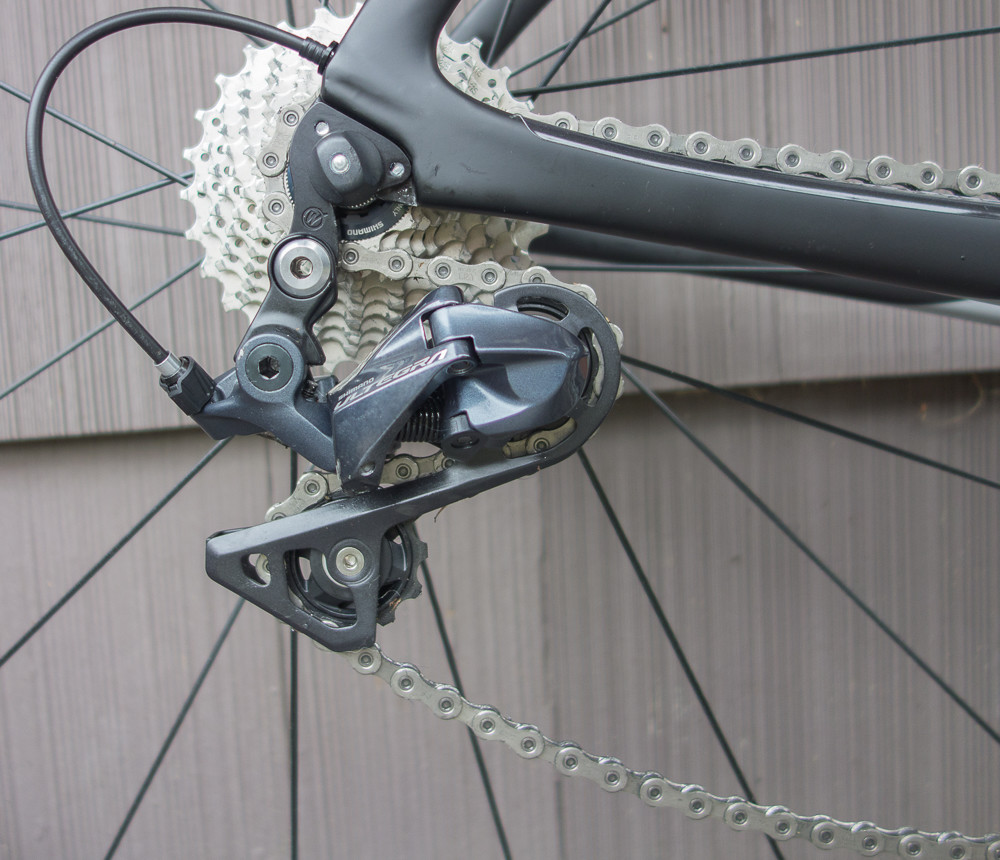
Furthermore, if you did try to install it like that, with the correct length chain, you would simply not be able to get it to work, not even badly. The chain would be completely slack (like in the pic), and no amount of B-screw turning is going to take that slack out. So, this is why I just had to shake my head when you quite confidently stated you could 'see the B-link was mounted incorrectly'.
Moving on to your "second point"... thanks for recognizing that you were completely wrong about the B-screw. I already knew that so you should have stopped there... because what you wrote after that tells me you are still very unclear what is actually happening. The B-screw does not move the pulley forward directly at all, it merely provides a stop for how far forward the rear derailleur body is allowed to pivot forward before the tension of the chain takes over at the pulley cage level. Backing out the b-screw will allow the derailleur body to pivot forward more before it hits the "stop". At that point, the chain tension will take over and begin pulling on the entire cage. If the chain is slack, screwing in the B-screw will force the derailleur body to pivot backwards, providing the b-screw stop on the derailleur is already against the b-screw. Then at some point dependent on the length of the chain and it's tension, the pulley wheels will be pulled apart from each other and the upper pulley will begin to move further away from the cassette cogs as well. Remember... the goal is to keep the upper pulley and chain as close to the cassette as possible without jamming throughout the entire range. It's kind of a balancing act, but chain length, B-screw adjustment, chain tension, cassette size, and where the derailleur is in space (dependent on hanger), all come into play here. Understanding how all these things are working together, or against each other, simultaneously is the key to being able to adjust this drive train lickety split, without a bunch of trial and error changes until you "think it's perfect".
Which brings me to your third point... based on a few things I've pointed out and pics I've posted you decided to play around with your B-screw a bit. Yet, you were quite adamant that it was perfectly adjusted and shifted awesomely before that. Simply backing off your b-screw has definitely helped a bit I can see, but it is far from where I'd consider it a success just yet. But perhaps you'll get there eventually. Let's hope your road hanger is a better fit here. The other thing that gets highlighted is that larger range cassettes have a few more challenges in getting as crisp shifting throughout the entire cassette range as might be possible with a smaller and closer ratio range cassette. You have the long cage derailleur I can see (required for the larger cassettes). I haven't worked with the long cage yet, and don't have a 34 or larger cassette lying around either. It may be that you will never be able to get it as close to the cassette in the smaller cogs as one might if they weren't using such a large cassette. That I don't know and haven't tested yet. So good luck in the future with that.
Sorry @pdlpusher1 if I'm coming across a little harsh here. I've known about this issue for a long time now, and have dealt with it. So when I see someone telling others that if they don't like the DM Road Hangers, it's only because they haven't used it, well... that too is not the case, and the DM hanger issue is a red herring in the wheel removal issue, as it absolutely does not make the removal of the wheel easier. It is simply how the new derailleur is designed that is causing that. But as I've said, it's more of an annoyance than anything, as it just makes wheel removal more of a pain than it was before. But the basic design is very good and it works super well. It wraps the cassette much like the 2015+ Campy derailleur does, but Campy didn't have to redesign the hanger to get there. The problem I see with the new DM hanger, is that unless the frame manufacturers were to start designing at least two separate hangers... one to be used with the Shimano Shadow derialleurs, then another to be used with Campagnolo/SRAM derailleurs, then it would leave Campagnolo and SRAM out in the cold and force a redesign of their derialleurs too. Or, in the alternative, Campy and SRAM would be left to come up with their own proprietary hangers for every different frame in order to be able to use their derailleurs. Haven't we got enough hangers around using the standard dimensions already... just take a browse through Wheels Manufacturing website (hangers section) to give you an idea of just how many there already are. So, back to the original question of this thread, the only real reason for frame manufacturers to start making DM hangers is because Shimano wants them to. If Shimano wants a perfectly placed DM hanger for every frame available (which would be better than the "one size fits all" solution that the B-link is), then let Shimano take on that responsibility. It's not trivial. When @beanbiken started a thread about the issue in March of 2017, I basically said that's just how it is, get used to it. I didn't know nearly as much about this issue as I do now. See my next post for what some folks, including Team SKY, are doing about it.
Colnago C64 - The Naked Build; Colnago C60 - PR99; Trek Koppenberg - Where Emonda and Domane Meet;
Unlinked Builds (searchable): Colnago C59 - 5 Years Later; Trek Emonda SL Campagnolo SR; Special Colnago EPQ
Unlinked Builds (searchable): Colnago C59 - 5 Years Later; Trek Emonda SL Campagnolo SR; Special Colnago EPQ
Oh yeah, before I forget, my username is @Calnago, not Colnago (let's respectfully leave that for Ernesto). When I started on WW I just used that play on words since some tri-guy used to call me that due to the bikes in my garage. My first name is Cal, or Calvin. I just noticed you've referred to me as "Colnago" too many times now for it to be just a typo.pdlpsher1 wrote: ↑Wed Jan 24, 2018 6:18 pmColnago,
I took another look at my bike with the B link this morning. Since the B link is responsible for how far back the RD can pivot, rotating the B link to the correct position will allow the RD to pivot further back, thus aiding wheel removal. Please give that a try and report back your findings. You may have to readjust the B screw (counter-clock wise) to move the upper pulley wheel forward after changing the B link position.
Ok, back to what I think will be my final post in this thread...
So what, if anything, are people doing about this potential annoyance with rear wheel removal? For the most part, probably nothing, since for most bikes it's just an annnoyance in comparison to how things used to be. And I alluded to this earlier in the thread talking about SKY and possibly Trek (I've read their new hangers are positioned slightly more rearward)... but here's a photo of Team Sky's Kwiatkowski's F10 from early last season. Judging by the dirt on the frame, maybe some larger tires were in play here, but they have definitely made some adjustments to the "B-link" placement. Namely, it is angled as rearward as possible, which is not where it would normally sit... thanks to @jwfinesse for posting this last year in an earlier thread about this issue...
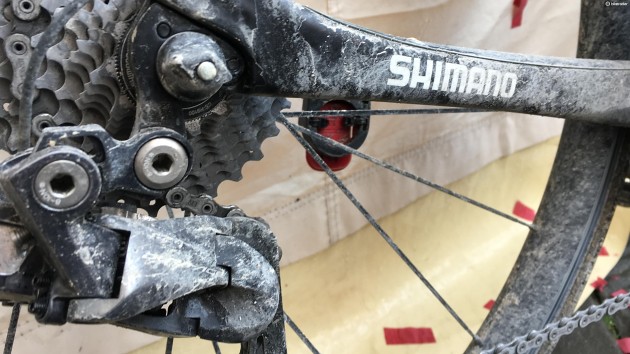
I can appreciate that probably most of you are looking at that photo wondering "what the hell am I supposed to be seeing here". Fair enough, I'll show you on one of the bikes I've been using for pics in this thread...
Here's the standard position of the derailleur... note the downward of the angle of the B-link...
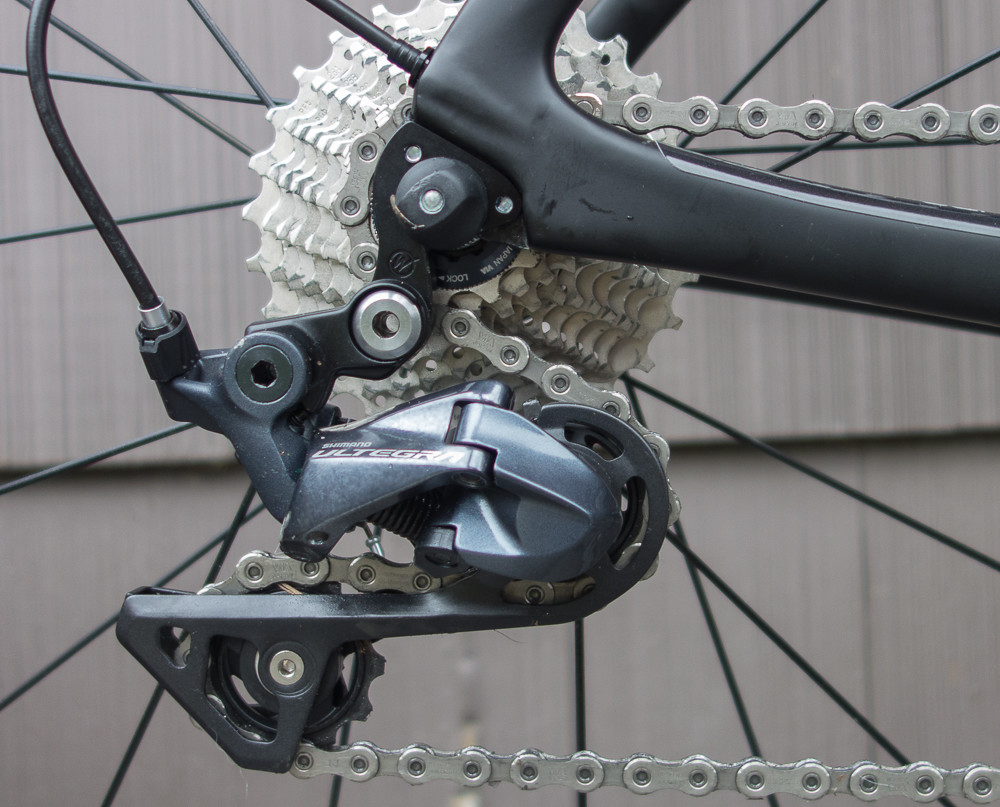
And below is the "adjusted" position.. note the B-link points straight back, essentially horizontal to the ground, positioning the derailleur as far back as possilbe. Also note the angle of the chain between the upper pulley and the cassette. It's steeper as a result of being pulled slightly down and back compared to the "standard" position in the first photo...
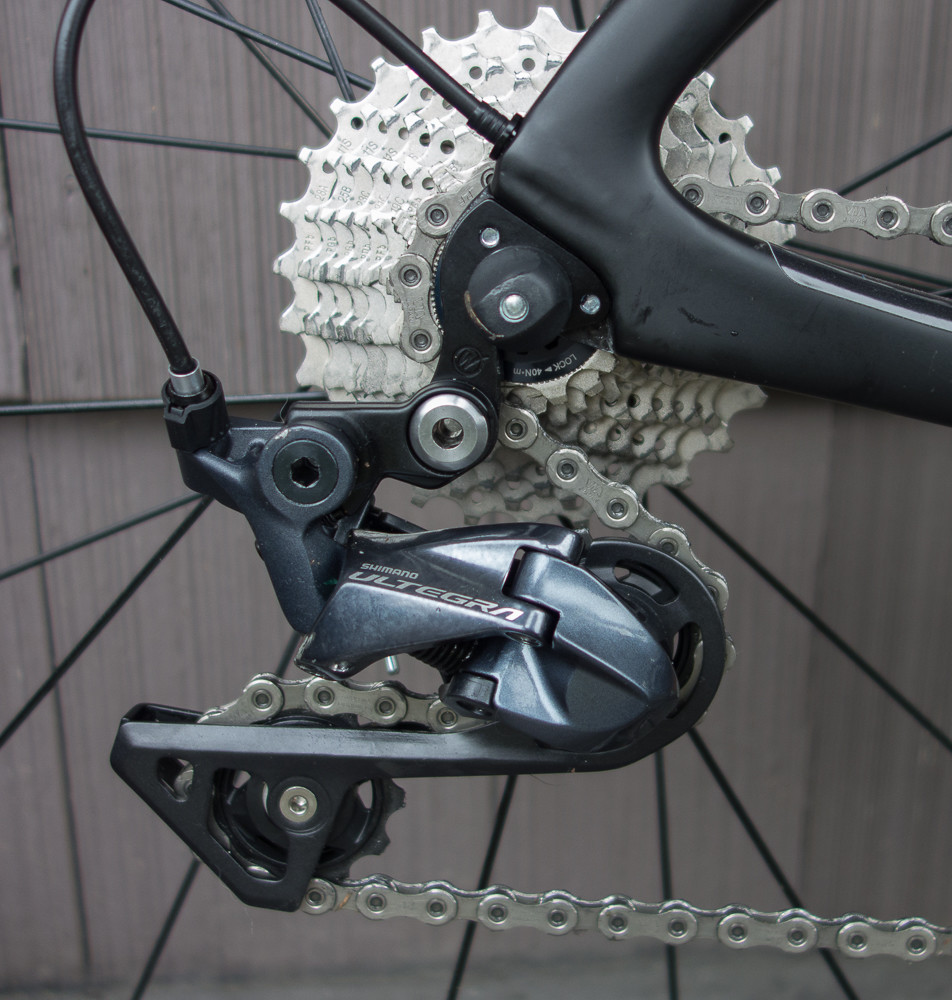
Now, you may be looking at those two photos thinking "C'mon, there's no difference". But there is, and it make a significant difference in how easy it is to remove a wheel with a 25mm Conti 4000s mounted from this frame. As opposed to be really frustrating, it's only a minor annoyance. Trouble is, Shimano specifically outlines not to do this...
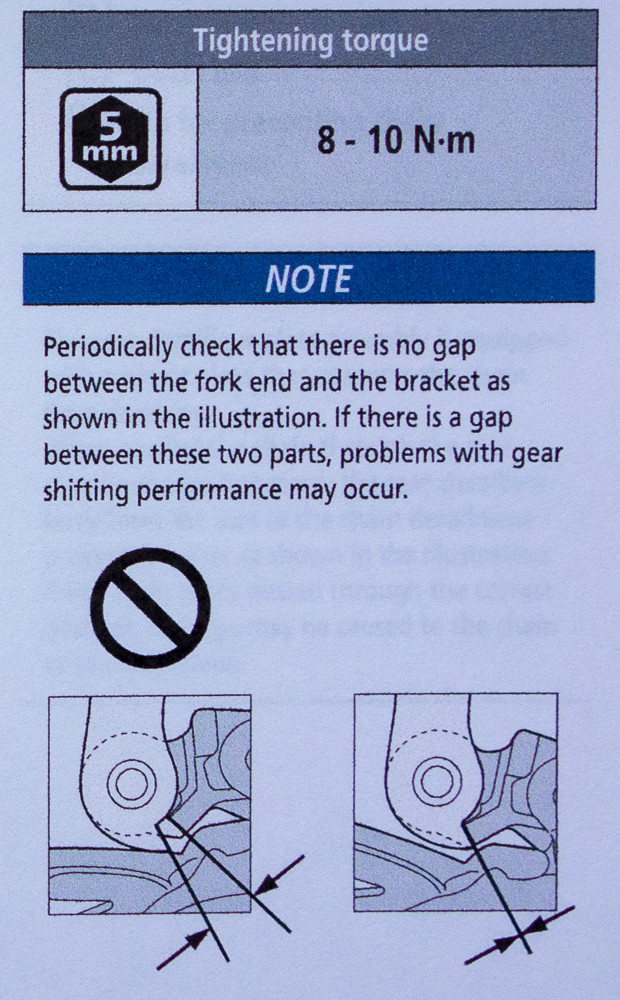
What they're referring to is the gap left between the regular hanger stop and the derailleur stop. The only thing holding it in place is a torque of around 8Nm. I suppose you could glue a little piece of something in that gap to essentially recreate the stop in a different position. They warn against possible poorer shifting performance, but really I don't think anyone would notice it, as it hasn't moved the pulley's that much further away from the cassette. Hell, just look at @pdlpusher1's distance and he says it shifts great.
So, just how much did I have to rotate the position of the derailleur... here's a photo showing exactly how much as shown by the gap between the derailleur tab and the hanger stop...

Another option would be to file away some material on the edge of the B-Link where the derailleur is stopped from moving any further rearward. I believe that's the solution adopted by @beanbiken when he first posted the thread about this issue. I think I'd rather just rotate the derailleur a bit away from the hanger stop and make sure it's torqued down. But unless wheel removal was really difficult, I think we just have to live with it going forward. But those of you with frames that might be a problem as I've identified might want to take this into consideration when thinking of "upgrading" your group.
I think that does it for me, here. Hope it at least sheds a little, or a lot, of light on an issue that keeps popping up from time to time. But like the dreaded cassette breaking, or cable eating shifters, I don't think Shimano really cares. They just want everyone to ride road bikes with really long chainstays and damnit... hurry up and put discs on your road bikes everyone. You neeeeed them. You waannnnt them. You are hypnotizzzzzeed!! But overall, it really is a superb group, shifting is silky smooth, you know. And the new rim brakes have awesome clearance (same as their DM brakes), are super stiff, and every bit as good as their DM brakes. Better I think due to the simplicity and they don't require drilling and threading mounting holes in your frame to install.
Colnago C64 - The Naked Build; Colnago C60 - PR99; Trek Koppenberg - Where Emonda and Domane Meet;
Unlinked Builds (searchable): Colnago C59 - 5 Years Later; Trek Emonda SL Campagnolo SR; Special Colnago EPQ
Unlinked Builds (searchable): Colnago C59 - 5 Years Later; Trek Emonda SL Campagnolo SR; Special Colnago EPQ
Sorry about the name mix up Calvin.
Here’s something very interesting. When you use a DM hanger the RD can pivot back much much further than if you have a regular hanger and a B link. I was able to compare the two bikes I have. On the one with the B link the RD hits the square part of the B link and it stops the RD from pivoting back further. On the DM hanger the stop is not there. I took some pictures to show the difference. This is why on my bike with the DM hanger the RD looks to be contorted. I’m able to swing the RD totally out of the way. You can’t do the same on your test bike because you have a B link. So I can definitely say that the DM hanger makes wheel removal easier. But I do agree with you that the shadow RD can be a problem for some bikes if you are using a B link.
These pictures show a startling difference between the B link and the DM hanger. On the bike with the DM hanger the RD is not even close to the wheel axle. The wheel can fall down without the RD in the way. With that said Shimano could easily modify the B link to allow the RD to pivot more. This way wheel removal is not a problem on bikes without the DM hanger.
RD pivoted back as far as it will go when it hits the B link

RD pivoted back as far as it will go when it hits the DM hanger

Top view of the RD hitting the DM hanger

Sent from my iPhone using Tapatalk
Here’s something very interesting. When you use a DM hanger the RD can pivot back much much further than if you have a regular hanger and a B link. I was able to compare the two bikes I have. On the one with the B link the RD hits the square part of the B link and it stops the RD from pivoting back further. On the DM hanger the stop is not there. I took some pictures to show the difference. This is why on my bike with the DM hanger the RD looks to be contorted. I’m able to swing the RD totally out of the way. You can’t do the same on your test bike because you have a B link. So I can definitely say that the DM hanger makes wheel removal easier. But I do agree with you that the shadow RD can be a problem for some bikes if you are using a B link.
These pictures show a startling difference between the B link and the DM hanger. On the bike with the DM hanger the RD is not even close to the wheel axle. The wheel can fall down without the RD in the way. With that said Shimano could easily modify the B link to allow the RD to pivot more. This way wheel removal is not a problem on bikes without the DM hanger.
RD pivoted back as far as it will go when it hits the B link

RD pivoted back as far as it will go when it hits the DM hanger

Top view of the RD hitting the DM hanger

Sent from my iPhone using Tapatalk
Well, this is really getting interesting... mostly because we're still both here and we haven't resorted to calling each other's mothers nasty names, but I do want to reach through this screen and strangle you at this point, in the most friendly way that a slow death by asphyxiation can possibly be.
Do you have a quick link on your chain by the way? Because it doesn't even look like that derailleur is stopping at the hanger yet, even though you've got it pulled "all the way" back. I'm thinking it may be stopping there as a result of maxing out your chain length and the pulley capacity (long chain and GS cage). What I'm getting at, is I'm wondering if without a chain attached, the derailleur would swing back even further so you could see it's edge actually touching the edge of the hanger, because it doesn't look like it is in your photo, but it could be hitting it internally somewhere I suppose that is invisible in the photo. But whether it is or not, it's really moot at this point.
We were discussing ease of rear wheel removal, and with the setup you have you will never have anything to worry about. But you will never experience the crispness of shifting that the new design in the derailleur is intended to give either. Your front pulley is barely in front of the rear axle, and far away from the cogs. This may very well be due to the fact that you're running a huge cassette with a long cage derailleur. I don't know for sure because I haven't worked with a cassette that large with new derailleurs yet, 32 is the max I've worked with. But even with that I was able to get things much better than what you show. I think it's more a case that your hanger is just placing your derailleur in the wrong place in space from where it's supposed to be. If I wanted to be absolutely sure I could easily remove my wheel, I could easily make a hanger that placed the derailleur 4 inches behind the wheel axle. No problems with wheel removal then for sure... it would shift like shit but damn, look at the wheel drop out when I flip the quick release. So, when talking about this issue, it's best to talk about it under the assumption that the derailleur is in the place that Shimano intends it to be for optimal performance.
Until you get things sorted out with your bike, there's not much point in talking further. By getting things "sorted out" I mean 2) verifying that your hanger is both designed correctly according to Shimano's specs, and 2) it is attached to the frame's dropout in a manner that positions the its place in space where it's supposed to be according to Shimano. To assist you with that, here is the derailleur spec for a DM hanger. I hope you can read it and understand it... this was posted in a previous thread on the topic by @ooo... I think it's the road spec, but without a label (I didn't source it myself), I suppose it could be the mtn bike spec. Either way, I suspect if you take some measurements from your current setup, they are not going to mesh very well with either one...

Also, I'd be very concerned about the radius on the "hook" of the hanger you have... It should almost be a right angle from the curved portion (1mm R according to spec), and that is definitely not. Colnago C59 hangers supplied by Pilo were designed like that, possibly thinking it didn't make a difference. Makes a big difference and I worked with them to show why, and they altered the design and sent me some new ones. I think @ooo recognized this as well with the hanger you showed earlier in the thread. I know exactly what he's talking about, but I think that's just one of the things that needs to change with that hanger, aside from length and geometry. There are other things that are quite different, but I can't say for sure if they would make a difference, but in particular look at the flat edge around the circular end of the spec. To me that looks like it might be acting as a "stop", but I don't know. Certainly don't see anything on your hanger that would qualify as a "stop" of any kind.
Here's yours... see that larger gradual "curve" which ends up being the hook... not good, and certainly not to shimanos spec. If you want I could show detailed pics of how much that difference can make in the ultimate positioning of the derailleur, albeit done with a Campy example, the effect it is the same. But I really think we need to take a break from this now and maybe come back to it if you get a new hanger if you'd like, but at this point we're really talking about just the idiosyncrasies of your particular bike. And it does have my interest for sure.

The other thing is that even when you do, if you ever do, get your derailleur sitting in space where it's supposed to be for optimal performance, it may just be that with a super large cassette, and the long cage derailleur, that you will never be able to get quite as good shifting as you would with a smaller cassette and a shorter cage. You initially said that your shifting was "perfect". So it's obviously acceptable to you. If someone came to me with a setup like that I'd have a hard time letting them go without making sure it couldn't be better. And simply by adjusting the B-screw a little bit, you've already gotten it better than when you earlier described it as "perfect". I'm suggesting there may still be quite a bit of ways to go.
I would definitely like to see things when you get the new road hanger for that frame, if you do, and reinstall everything from scratch, meaning a new chain or at least verifying that the one you're using is the correct length. Your initial description of your install made me cringe a bit... what was it again... you initially had the chain so long, that you couldn't even take the slack out of it with the B-screw, so you adjusted the B-screw, then shortened the chain? Hmmm... ok then. Maybe your chain length is good, maybe it's not... but since you've already got a massive cassette on there anyway, how about when you get the new (hopefully proper) hanger, first make absolutely sure your chain length is correct according to the way Shimano would like you to do it, then go from there as a starting point. I once compared what the chain length would be using Shimano's method, versus Campy's method, and I think it ended up being the same, and I'm also thinking it was probably coincidence. With a cassette as big as you're using, use Shimano's method.
Perhaps later today I'll post up a couple more pics of a couple different "perfectly" set up drivetrains just for comparison. Don't hold me to it however. This stuff should probably be taken to some framebuilders forum at this point. But for Weightweenies, I see they're talking about espresso in another thread... and what kind of poseurs there are in yet another thread. Those threads are just sounding so much more fun to me right now.
Good luck!
Do you have a quick link on your chain by the way? Because it doesn't even look like that derailleur is stopping at the hanger yet, even though you've got it pulled "all the way" back. I'm thinking it may be stopping there as a result of maxing out your chain length and the pulley capacity (long chain and GS cage). What I'm getting at, is I'm wondering if without a chain attached, the derailleur would swing back even further so you could see it's edge actually touching the edge of the hanger, because it doesn't look like it is in your photo, but it could be hitting it internally somewhere I suppose that is invisible in the photo. But whether it is or not, it's really moot at this point.
We were discussing ease of rear wheel removal, and with the setup you have you will never have anything to worry about. But you will never experience the crispness of shifting that the new design in the derailleur is intended to give either. Your front pulley is barely in front of the rear axle, and far away from the cogs. This may very well be due to the fact that you're running a huge cassette with a long cage derailleur. I don't know for sure because I haven't worked with a cassette that large with new derailleurs yet, 32 is the max I've worked with. But even with that I was able to get things much better than what you show. I think it's more a case that your hanger is just placing your derailleur in the wrong place in space from where it's supposed to be. If I wanted to be absolutely sure I could easily remove my wheel, I could easily make a hanger that placed the derailleur 4 inches behind the wheel axle. No problems with wheel removal then for sure... it would shift like shit but damn, look at the wheel drop out when I flip the quick release. So, when talking about this issue, it's best to talk about it under the assumption that the derailleur is in the place that Shimano intends it to be for optimal performance.
Until you get things sorted out with your bike, there's not much point in talking further. By getting things "sorted out" I mean 2) verifying that your hanger is both designed correctly according to Shimano's specs, and 2) it is attached to the frame's dropout in a manner that positions the its place in space where it's supposed to be according to Shimano. To assist you with that, here is the derailleur spec for a DM hanger. I hope you can read it and understand it... this was posted in a previous thread on the topic by @ooo... I think it's the road spec, but without a label (I didn't source it myself), I suppose it could be the mtn bike spec. Either way, I suspect if you take some measurements from your current setup, they are not going to mesh very well with either one...

Also, I'd be very concerned about the radius on the "hook" of the hanger you have... It should almost be a right angle from the curved portion (1mm R according to spec), and that is definitely not. Colnago C59 hangers supplied by Pilo were designed like that, possibly thinking it didn't make a difference. Makes a big difference and I worked with them to show why, and they altered the design and sent me some new ones. I think @ooo recognized this as well with the hanger you showed earlier in the thread. I know exactly what he's talking about, but I think that's just one of the things that needs to change with that hanger, aside from length and geometry. There are other things that are quite different, but I can't say for sure if they would make a difference, but in particular look at the flat edge around the circular end of the spec. To me that looks like it might be acting as a "stop", but I don't know. Certainly don't see anything on your hanger that would qualify as a "stop" of any kind.
Here's yours... see that larger gradual "curve" which ends up being the hook... not good, and certainly not to shimanos spec. If you want I could show detailed pics of how much that difference can make in the ultimate positioning of the derailleur, albeit done with a Campy example, the effect it is the same. But I really think we need to take a break from this now and maybe come back to it if you get a new hanger if you'd like, but at this point we're really talking about just the idiosyncrasies of your particular bike. And it does have my interest for sure.

The other thing is that even when you do, if you ever do, get your derailleur sitting in space where it's supposed to be for optimal performance, it may just be that with a super large cassette, and the long cage derailleur, that you will never be able to get quite as good shifting as you would with a smaller cassette and a shorter cage. You initially said that your shifting was "perfect". So it's obviously acceptable to you. If someone came to me with a setup like that I'd have a hard time letting them go without making sure it couldn't be better. And simply by adjusting the B-screw a little bit, you've already gotten it better than when you earlier described it as "perfect". I'm suggesting there may still be quite a bit of ways to go.
I would definitely like to see things when you get the new road hanger for that frame, if you do, and reinstall everything from scratch, meaning a new chain or at least verifying that the one you're using is the correct length. Your initial description of your install made me cringe a bit... what was it again... you initially had the chain so long, that you couldn't even take the slack out of it with the B-screw, so you adjusted the B-screw, then shortened the chain? Hmmm... ok then. Maybe your chain length is good, maybe it's not... but since you've already got a massive cassette on there anyway, how about when you get the new (hopefully proper) hanger, first make absolutely sure your chain length is correct according to the way Shimano would like you to do it, then go from there as a starting point. I once compared what the chain length would be using Shimano's method, versus Campy's method, and I think it ended up being the same, and I'm also thinking it was probably coincidence. With a cassette as big as you're using, use Shimano's method.
Perhaps later today I'll post up a couple more pics of a couple different "perfectly" set up drivetrains just for comparison. Don't hold me to it however. This stuff should probably be taken to some framebuilders forum at this point. But for Weightweenies, I see they're talking about espresso in another thread... and what kind of poseurs there are in yet another thread. Those threads are just sounding so much more fun to me right now.
Good luck!
Last edited by Calnago on Thu Jan 25, 2018 7:35 pm, edited 1 time in total.
Colnago C64 - The Naked Build; Colnago C60 - PR99; Trek Koppenberg - Where Emonda and Domane Meet;
Unlinked Builds (searchable): Colnago C59 - 5 Years Later; Trek Emonda SL Campagnolo SR; Special Colnago EPQ
Unlinked Builds (searchable): Colnago C59 - 5 Years Later; Trek Emonda SL Campagnolo SR; Special Colnago EPQ
@Calnago, yes, it's road spec. mtb uses different angle +10°. Same 10° difference can be found on road vs mtb Bracket axle units visually:

using bracket axle unit like this is like replacing road bracket axle unit with mtb bracket axle unit:

road shadow bracket:

mtb shadow bracket:

with mtb bracket axle shifting road cassette will be slower, but you can try to get it closer to cassette by using bigger top pulley (method not tested)

using bracket axle unit like this is like replacing road bracket axle unit with mtb bracket axle unit:

road shadow bracket:

mtb shadow bracket:

with mtb bracket axle shifting road cassette will be slower, but you can try to get it closer to cassette by using bigger top pulley (method not tested)
Last edited by ooo on Thu Jan 25, 2018 6:52 pm, edited 5 times in total.
'
- wheelbuilder
- Posts: 1213
- Joined: Wed Feb 08, 2017 2:10 am
Thanks to Calnago and to some extent pdlpshr (even though I'm not sure you understand the difficulties that I was trying to describe with certain bikes). Your bike doesn't have a wheel removal issue, so this isn't applicable to you at all really. I think the majority of members active in this thread don't have the issue either, but that doesn't negate the experiences I have had with the bikes I have mentioned. One Dogma, one BH, and one Franco. 9100 shifts like a dream. I have installed probably 25 9100 groupsets over the last year and a half. The shift action is buttery smooth and light. The rear derailleur interacts with the cassette in a more efficient manner than 9000, and the toggle front derailleur is genius in my opinion with a very easy set up, elimination of a barrel adjuster, and the lightest fastest action Shimano has ever had with a front derailleur. These things are all true and it is a great groupset for 99% of users. The fact of the matter is though, that certain bikes, in certain sizes, with certain carbon layups present a very difficult wheel removal and installation problem. This is a fact. Thanks to both of you guys for posting so many photos and descriptions. This thread will be very helpful to every user of this site for years to come and should probably be a sticky. It has explained the B link in a way I have yet to see equaled in any forum, review, or even on S-Tec.
Never cheer before you know who is winning
Wow... you mean there's others actually looking at this thread still? Ha... yes, I know it's gotten kind of esoteric and technical at times (and I was just getting warmed up), but I'm not going to continue to try to use @pdlpsher1's bike as an example to explain this issue. I am interested in his bike mostly to find out why the derailleur seems to have ended up in what looks like such a different place than Shimano intends it to be for optimal performance. The fact that he has a mtn bike hanger on a road frame certainly may explain a large part of it for sure. But with 425mm chainstays, and providing the front chainstay bridge (if there is one) is far enough forward, then I can't imagine him having any wheel removal issue at all, even if the derailleur was in the correct place as shimano intended... mainly further forward for sure and maybe a little lower. As it stands now, he's getting no more wrap than derailleurs from 10 years ago did.
And yes, I continued with this thread because I've known about the "issues" for well over a year, and people ask "why is my wheel so hard to get out now? It wasn't like that before...". And my response has usually been "well, it's just the way it is now". I don't think Shimano really gave much consideration to this issue during development, and to be honest it's only going to affect pretty specific frames... tight road race geometry, shortish chainstays, fat tires, thick carbon layup behind the bottom bracket... those things all combine to contribute to the issue. Trouble is, and why I have looked at this so closely, is that I love the road bike for all it is... tight, super handling, just a marvel and joy to ride. I don't want to see the road bike "devolve" into some sluggish long chainstay beast of a bike. Ok, I exaggerate, and those have their place... my touring bike is also a joy to ride, fully loaded for 8 weeks at a time on some far off journey. But it's not the equivalent of a Porsche. And when I get back from one of those laden down touring trips, and jump back on my road bike... I quite frankly have almost fallen off because it's so agile and quick handling in comparison. But after a few minutes it's just fine again, and I can't imagine wanting anything different. They all have their place, I just don't want to see it change into something less than it's become.
And thanks @ooo for posting. You must be somewhat following the thread as well... you've been very good at posting some technical things from Shimano that I've wondered if you work for them, or have close ties at all?
Anyway, here's the other thread on this issue, started by @beanbiken last March, 2017... when the issue was starting to become "a thing". Now that a year has passed, I've gotten over it and really learned about the idiosyncrasies of setting up the new stuff, and I suppose I wouldn't trade the new for the old all things considered. But if you do have issues with rear wheel removal, rest assured... it's not you, it's them! Lol
viewtopic.php?f=3&t=144421&hilit=rear+wheel+removal
And yes, I continued with this thread because I've known about the "issues" for well over a year, and people ask "why is my wheel so hard to get out now? It wasn't like that before...". And my response has usually been "well, it's just the way it is now". I don't think Shimano really gave much consideration to this issue during development, and to be honest it's only going to affect pretty specific frames... tight road race geometry, shortish chainstays, fat tires, thick carbon layup behind the bottom bracket... those things all combine to contribute to the issue. Trouble is, and why I have looked at this so closely, is that I love the road bike for all it is... tight, super handling, just a marvel and joy to ride. I don't want to see the road bike "devolve" into some sluggish long chainstay beast of a bike. Ok, I exaggerate, and those have their place... my touring bike is also a joy to ride, fully loaded for 8 weeks at a time on some far off journey. But it's not the equivalent of a Porsche. And when I get back from one of those laden down touring trips, and jump back on my road bike... I quite frankly have almost fallen off because it's so agile and quick handling in comparison. But after a few minutes it's just fine again, and I can't imagine wanting anything different. They all have their place, I just don't want to see it change into something less than it's become.
And thanks @ooo for posting. You must be somewhat following the thread as well... you've been very good at posting some technical things from Shimano that I've wondered if you work for them, or have close ties at all?
Anyway, here's the other thread on this issue, started by @beanbiken last March, 2017... when the issue was starting to become "a thing". Now that a year has passed, I've gotten over it and really learned about the idiosyncrasies of setting up the new stuff, and I suppose I wouldn't trade the new for the old all things considered. But if you do have issues with rear wheel removal, rest assured... it's not you, it's them! Lol
viewtopic.php?f=3&t=144421&hilit=rear+wheel+removal
Colnago C64 - The Naked Build; Colnago C60 - PR99; Trek Koppenberg - Where Emonda and Domane Meet;
Unlinked Builds (searchable): Colnago C59 - 5 Years Later; Trek Emonda SL Campagnolo SR; Special Colnago EPQ
Unlinked Builds (searchable): Colnago C59 - 5 Years Later; Trek Emonda SL Campagnolo SR; Special Colnago EPQ
I study public documents for my personal use. I don't have any special access, but with some hard to find public documents it is not clear if it is ok to repost information, so I don't post additional info until I am sure it is ok. (That is why in my previous post I decided to use visual information instead of documents to illustrate difference of mtb vs road shadow brackets)
'
@ooo: Well wherever you get it from I look forward to when you share it. I could tell on a few occasions from reading your posts that there was some detailed knowledge that many don’t have behind them. The example in this thread was your little mocked up change to the “hook” in @pdlpsher1’s derailleur hanger. I noticed that right away too. Paragon needs to fix that as a first step.
Colnago C64 - The Naked Build; Colnago C60 - PR99; Trek Koppenberg - Where Emonda and Domane Meet;
Unlinked Builds (searchable): Colnago C59 - 5 Years Later; Trek Emonda SL Campagnolo SR; Special Colnago EPQ
Unlinked Builds (searchable): Colnago C59 - 5 Years Later; Trek Emonda SL Campagnolo SR; Special Colnago EPQ
I will add more information if/when it will be posted on more common Shimano information resources, having some numbers and using images of components' parts as visual examples is a safer way to avoid any problems in the future.
Suggested change to the hook - ok if @pdlpsher1 have two (mtb) hooks on hands, but if he only have single (mtb) hook - it is better to wait for second (road) hook, so we can compare them and @pdlpsher1 will have even more exclusive frame - with both mtb and road direct mount hangers.
Suggested change to the hook - ok if @pdlpsher1 have two (mtb) hooks on hands, but if he only have single (mtb) hook - it is better to wait for second (road) hook, so we can compare them and @pdlpsher1 will have even more exclusive frame - with both mtb and road direct mount hangers.
'
Yes, that's a nice way of describing it... "exclusive"... why didn't I think of that.. lol. And Yes, I hope he does overlay the two versions when he has them both in hand so we can see them.
Colnago C64 - The Naked Build; Colnago C60 - PR99; Trek Koppenberg - Where Emonda and Domane Meet;
Unlinked Builds (searchable): Colnago C59 - 5 Years Later; Trek Emonda SL Campagnolo SR; Special Colnago EPQ
Unlinked Builds (searchable): Colnago C59 - 5 Years Later; Trek Emonda SL Campagnolo SR; Special Colnago EPQ
I was going to reply on this thread this morning but before I could finish the reply I got busy for the rest of the day. Thanks everyone for the discussions. I’ve learned a lot from the discussions and some experiments in my own garage. Today I did a ride on my bike with revised B screw adjustment. I think the shifts are crisper and faster. And it seemed a bit quieter. Since I have Di2, shifting has never been an issue even before the B screw adjustment. One thing that is unique about my bike is the 11-34 cassette. The 34 cog is limiting how close I can get the upper pulley to the cogs, especially on the higher gears. On the lower gears my pulley is much closer to the cogs.
Through my experiments I discovered that the RD can pivot back in a way that will help wheel removal easier (on those bikes where wheel removal is not an issue). For those bikes with the wheel removal issue, I believe a DM hanger will help as the B link is no longer acting as a ‘stop’ to how far the RD can pivot. I hope everyone can draw the same conclusions after looking at the pictures I posted in my last post. But I also understand that a DM hanger is hard to come by at this time. I agree that Shimano should take an active role in providing a solution to this potential problem not via a DM hanger but by revising the B link.
When I get my road-specific DM hanger I will report back on the differences.
Sent from my iPhone using Tapatalk
Through my experiments I discovered that the RD can pivot back in a way that will help wheel removal easier (on those bikes where wheel removal is not an issue). For those bikes with the wheel removal issue, I believe a DM hanger will help as the B link is no longer acting as a ‘stop’ to how far the RD can pivot. I hope everyone can draw the same conclusions after looking at the pictures I posted in my last post. But I also understand that a DM hanger is hard to come by at this time. I agree that Shimano should take an active role in providing a solution to this potential problem not via a DM hanger but by revising the B link.
When I get my road-specific DM hanger I will report back on the differences.
Sent from my iPhone using Tapatalk
This thread sort of has me feeling like a kid who can't go out to play till his homework is done. So I will finish what I have to say, since I think it is a worthwhile post to have somewhere on the internet for others. I'll deal with some things @pdlpshr1 just stated in the post above in a bit... but for now that's just a distraction. And before I go any further... I want to repeat... this whole difficulty in wheel removal thing only affects probably a fairly small number of bikes, but it can be annoying to those that it does affect. The new design is good in that it both tries to "wrap" all the cogs as much as possible, even when wide range cassettes are involved. But in order to do so, Shimano wants that attach point to their derailleur body to be set way back from a standard derailleur. Hence they have provided the B-link, as a removable part of the derailleur, but they'd like frame manufacturers to produce a hanger specific to Shimano's needs for all of their frames. So far, frame manufacturers have been slow to go down that route. The B-link attaches to a regular rear derailleur hanger and places the derailleur where it needs to be according to Shimano specs... further back. If a direct hanger is in play, then you don't need the B-link; you just remove the B-Link and attach the derailleur directly to the DM hanger. DM hangers are NOT compatible with Campagnolo or (I presume) SRAM derailleurs. And contrary to what some people seem to think, DM hangers also do not make wheel removal easier. In fact, I can't think of a situation where the new derailleur, regardless of whether it is mounted on a Direct Mount hanger or on a regular hanger with the B-Link will make wheel removal easier than it was before. And this goes for both the new Shimano "Shadow" derailleurs or the derailleurs from Campy since 2015 which incorporate their "Embrace" design. But would I want to return to the designs previous to these... absolutely not. The whole idea behind a rear derailleur is to keep the chain as close to the cogs and wrap as many teeth as possible throughout the cassette's entire range. Do that and shifting is crisp and precise. Can I accept a little more difficulty in rear wheel removal if that can be achieved? Yes, I can. It's just that for some, a little more finesse may be required to remove the rear wheel... and in extreme cases... one may have to let some air out of the tire to do this. But that's really rare. Ok, now that that is out of the way....
Let's first address what @ooo and I were briefly exchanging posts on above. I don't think @ooo's native language is English, but after thinking about his post, I realized that while we were talking about same thing on the hanger (the "hook"), we were talking about two different aspects of it. @ooo was talking about the difference in angle of that hook depending on whether it's a mountain bike hanger or a road hanger. They are different by 10 degrees. That's significant. But I was looking at a very small detail in where the inside radius of that hook meets the main hanger body. I can best show this in pictures and I'm going to use a Camapgnolo SR derailleur and a C59 derailleur hanger as an example to show what I'm talking about. Note: It could very well be that this does not apply to Shimano derailleurs if the stop on the derailleur does not come in contact with the full face of the hook like Campagnolo deraileurs do. On to some pics...
First... A stock Colnago C59 Derailleur hanger on the left, and a replacement hanger provided by Pilo (manufacturer of hangers and other parts based in Israel, they seem to be to Europe what Wheels Manufacturing is to North America)...
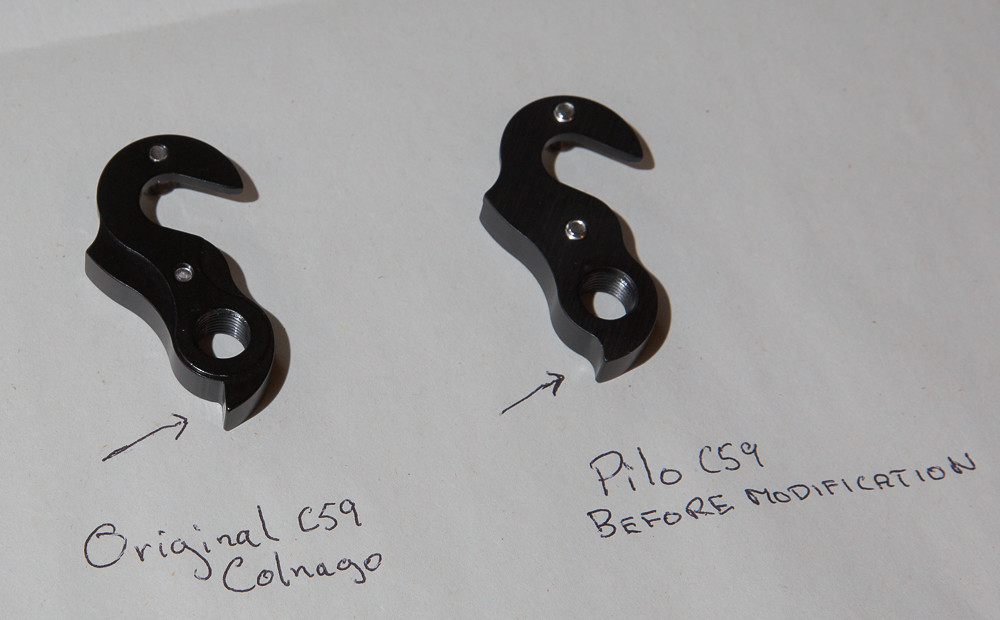
Ok... assuming you can see the difference in the "hook" inside radius (the drawn arrows are pointing to the area), then let's have a look how that affects things when a derailleur is actually attached... Campy Super Record in this case... first just a pic of the whole derailleur attached to a hanger (not on bike) so you can get a better idea of what the closeups following are focusing on...
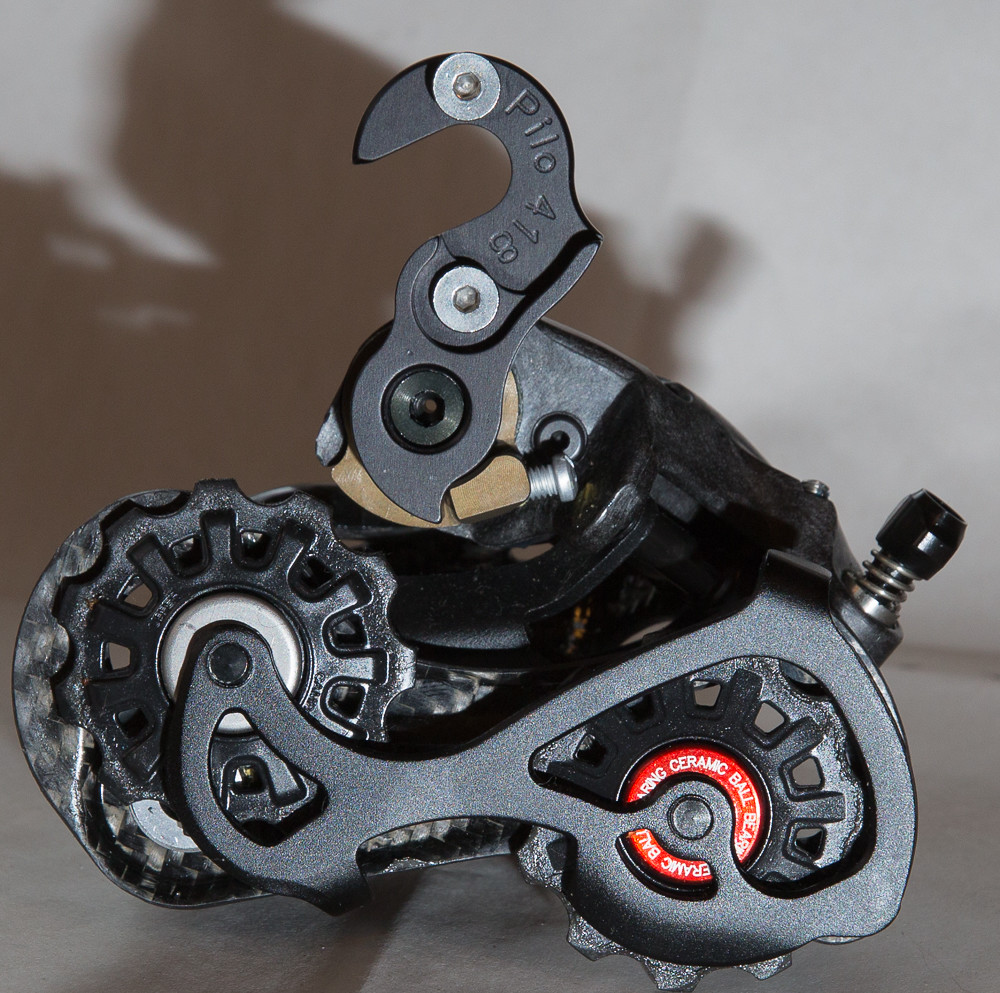
You can see the gap that is created when the inner edge of the derailleur stop comes into contact with the large radius hanger stop. That is way out of what Shimano, or Campy want to see. They both specify a 1mm radius at that point... Anyway, below is a closeup of the area... imagine that open angle extrapolated outwards and you can begin to appreciate that that derailleur is being stopped quite a bit before where it should be...
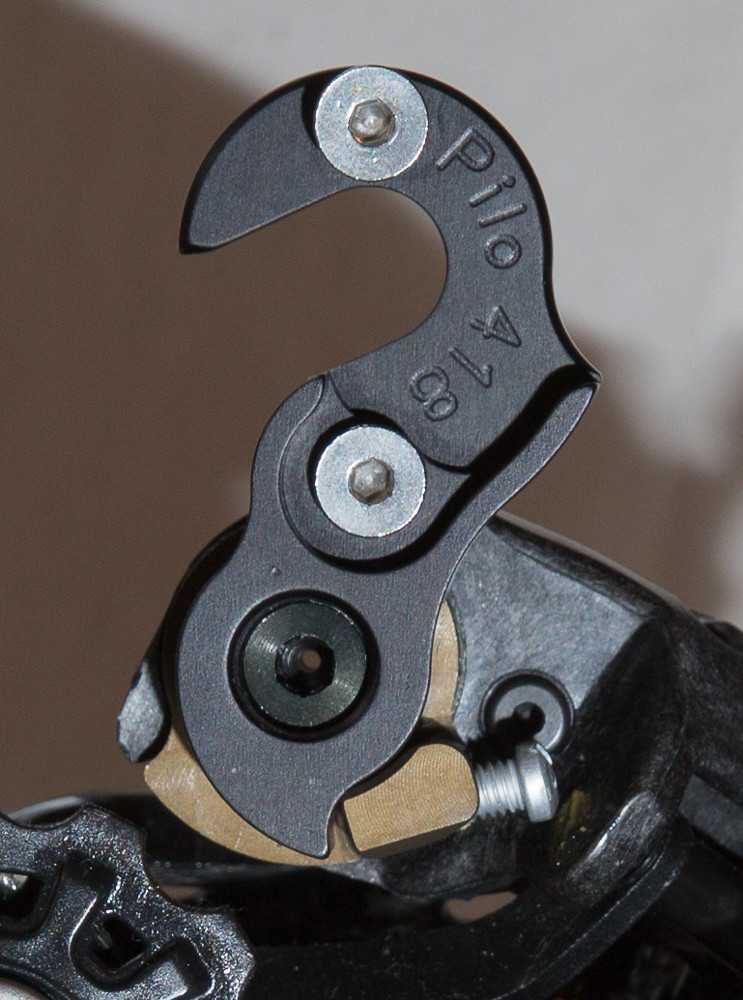
It only took an email to Pilo with pics similar to these for them to say... "Thanks for those pics and explanation, we will change the design". They did so, and were super pleasant about it. Wheels Manufacturing in the USA wasn't even making a hanger for the C59 at the time, which is why I sourced out Pilo in the first place. I should say right now, that the quality between Pilo and Wheels Manufacturing is the same, but I was super impressed that Pilo was so quick to recognize the need for the design change. Below is a closeup of the redesigned C59 hanger. They sent me a couple... (oh, and that's not a crack, but blown up like this it might appear that way, it's just a bit of grease that I didn't do a good job of cleaning off for the photo, it's actually never been installed; the grease was residual on the threads of the derailleur bolt)...
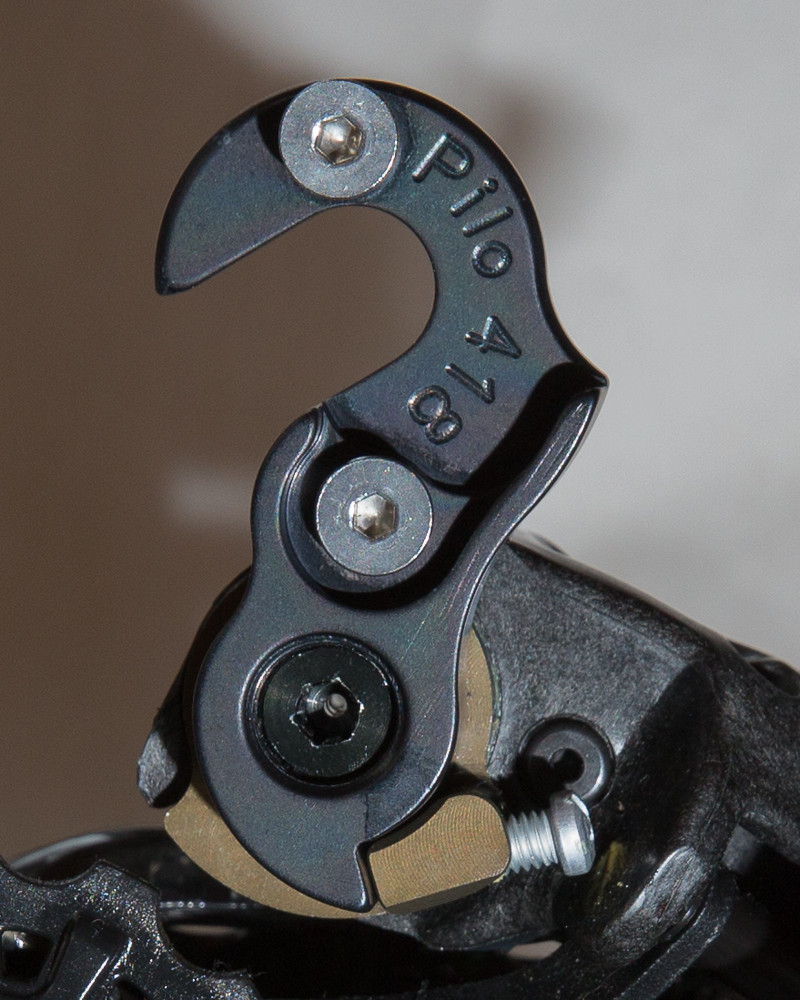
And one of both the before and after versions of the Pilo C59 hangers...
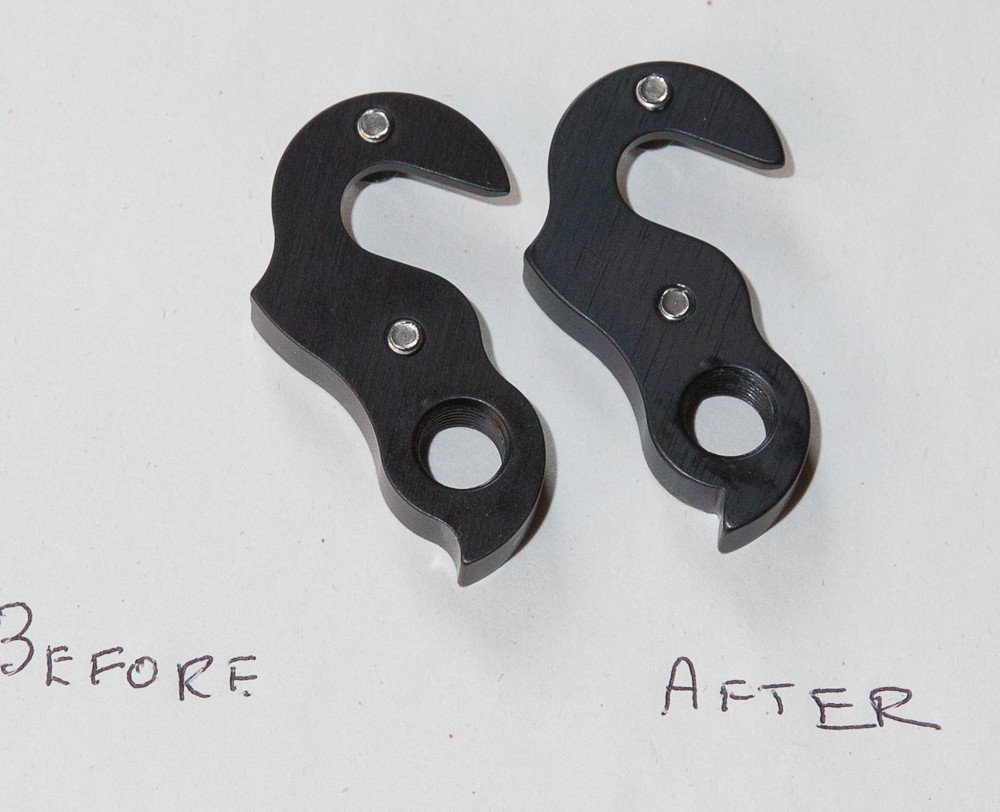
So, why did I show you that you might ask... well... because it's one of the things that is also clearly out of spec on @pdlpsher1's hanger from Paragon. Now, as I noted before, this may or may not affect a Shimano derailleur in the same way as it does Campy derailleurs simply because Shimano's derailleur tab stop is much thinner (at least it used to be) than Campy's. So, if the that's the case, that large inside radius may not even get touched. And you couldn't mount a campy derailleur to this anyway, as it would place campy's derailleur in a place it doesn't want to be. But it's something you should look for regardless of where you get your hangers from, especially if you run Campy.
Ok... so here's the DM hanger that @pdlpsher1 has on his bike...

Looking at it I can see at least two things that do not conform to Shimano's Direct Mount Road Hanger specification...
1) The inside radius of the "hook" as I just finished explaining is clearly much larger than the 1mm radius specificed. Does that affect Shimano's new derailleurs. Probably not, but I still need to check out the tab that butts up against it on a new Shimano derailleur. I will report back when I do. But it would certainly affect a Campy derailleur, which is a moot point when talking about the DM for sure, but in the event you're getting a replacement hanger, whether from Paragon, Wheels Mfg, Pilo, or somewhere else, this is something you should consider.
2) The flat edge (opposite the hook on the top side of the hanger) that provides a stop for the rear derailleur... it is absent on the Paragon DM hanger, albeit it is a mountain bike hanger, but I'm not certain that their road hanger is different in this regard... I suppose it could be... but in any case here once again is the spec for the road hanger. Note the flat edge I'm talking about...

So, when @pdlphsr1 pulls his road derailleur back, it's got no stop. It ends up looking like this... take note of where the edge of the derailleur hits the B-edge of the DM hanger on top...
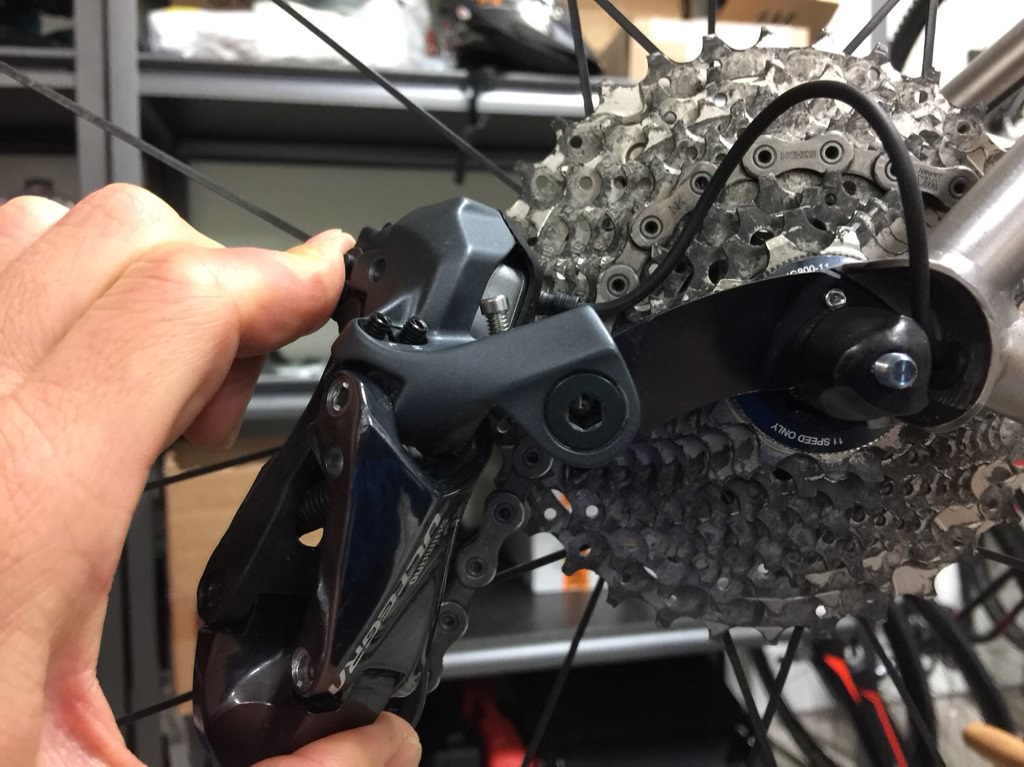
Now let's look at what a BMC looks like when you pull the derailleur back as far as it can go. It has a properly designed and positioned Direct Mount hanger...
From the side... as far back as it can go... also look at how much lower it seems to be in relation to the wheel axle than @pdlpshr1's photo above. Although, I cannot tell if his bike is level or not, but judging by the bit of chainstay I can see... even if it's not quite level I suspect it's sitting a lot higher than the hanger on the BMC... Also note that the rear wheel is easy to remove in the pic below. It has good clearance up front.
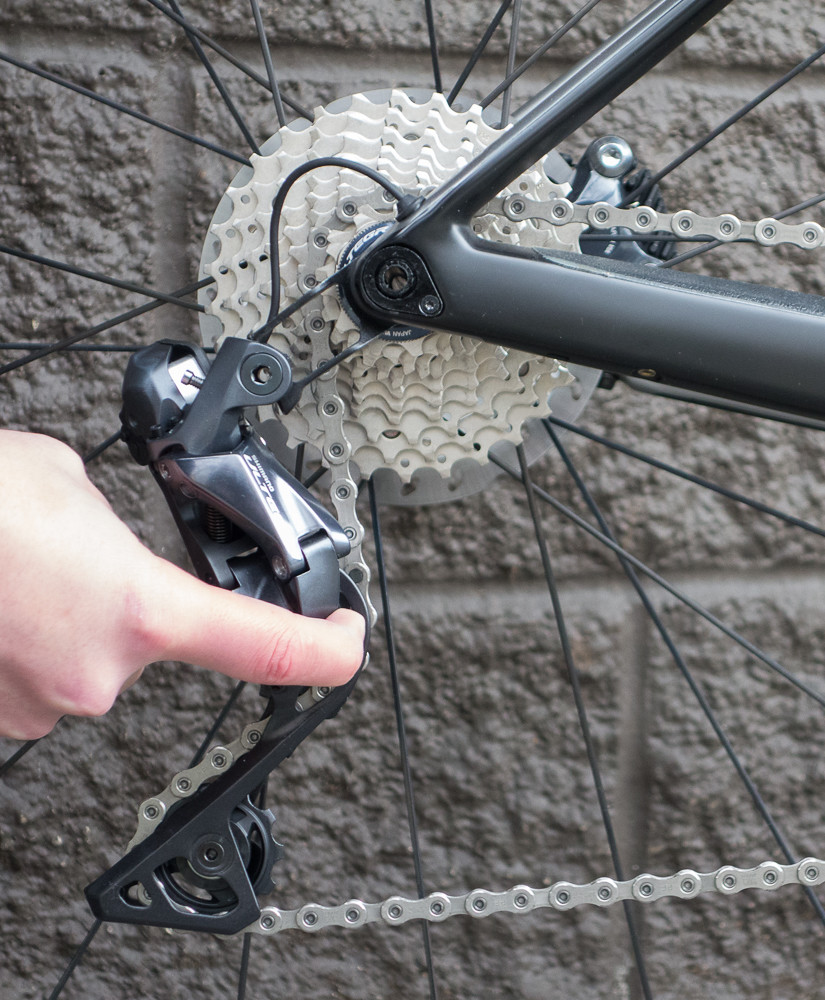
And from the top... to show that it has stopped against the DM hanger...
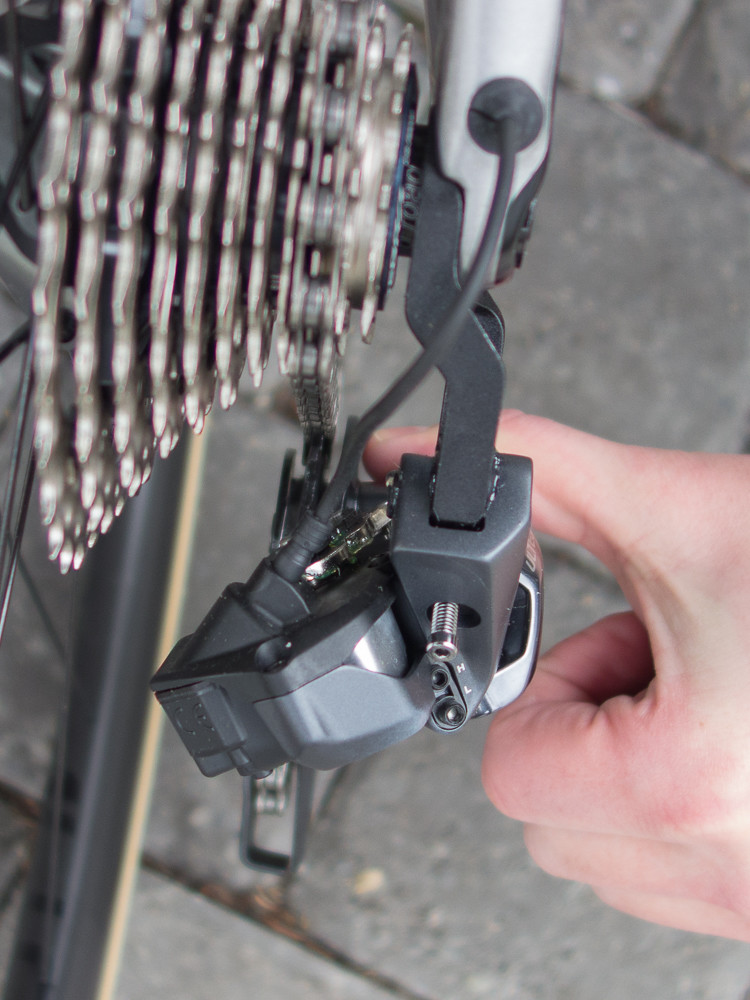
But all this talk of hangers is just preamble for next post, because even if the hanger itself was designed exactly to Shimano's specs... it cannot be taken without considering how it mounts to the frame. The two are inextricably tied and you can't talk about one without knowing how it interfaces with the other. That's the subject of my next post to follow. But I need a bit of a break for now.
Let's first address what @ooo and I were briefly exchanging posts on above. I don't think @ooo's native language is English, but after thinking about his post, I realized that while we were talking about same thing on the hanger (the "hook"), we were talking about two different aspects of it. @ooo was talking about the difference in angle of that hook depending on whether it's a mountain bike hanger or a road hanger. They are different by 10 degrees. That's significant. But I was looking at a very small detail in where the inside radius of that hook meets the main hanger body. I can best show this in pictures and I'm going to use a Camapgnolo SR derailleur and a C59 derailleur hanger as an example to show what I'm talking about. Note: It could very well be that this does not apply to Shimano derailleurs if the stop on the derailleur does not come in contact with the full face of the hook like Campagnolo deraileurs do. On to some pics...
First... A stock Colnago C59 Derailleur hanger on the left, and a replacement hanger provided by Pilo (manufacturer of hangers and other parts based in Israel, they seem to be to Europe what Wheels Manufacturing is to North America)...

Ok... assuming you can see the difference in the "hook" inside radius (the drawn arrows are pointing to the area), then let's have a look how that affects things when a derailleur is actually attached... Campy Super Record in this case... first just a pic of the whole derailleur attached to a hanger (not on bike) so you can get a better idea of what the closeups following are focusing on...

You can see the gap that is created when the inner edge of the derailleur stop comes into contact with the large radius hanger stop. That is way out of what Shimano, or Campy want to see. They both specify a 1mm radius at that point... Anyway, below is a closeup of the area... imagine that open angle extrapolated outwards and you can begin to appreciate that that derailleur is being stopped quite a bit before where it should be...

It only took an email to Pilo with pics similar to these for them to say... "Thanks for those pics and explanation, we will change the design". They did so, and were super pleasant about it. Wheels Manufacturing in the USA wasn't even making a hanger for the C59 at the time, which is why I sourced out Pilo in the first place. I should say right now, that the quality between Pilo and Wheels Manufacturing is the same, but I was super impressed that Pilo was so quick to recognize the need for the design change. Below is a closeup of the redesigned C59 hanger. They sent me a couple... (oh, and that's not a crack, but blown up like this it might appear that way, it's just a bit of grease that I didn't do a good job of cleaning off for the photo, it's actually never been installed; the grease was residual on the threads of the derailleur bolt)...

And one of both the before and after versions of the Pilo C59 hangers...

So, why did I show you that you might ask... well... because it's one of the things that is also clearly out of spec on @pdlpsher1's hanger from Paragon. Now, as I noted before, this may or may not affect a Shimano derailleur in the same way as it does Campy derailleurs simply because Shimano's derailleur tab stop is much thinner (at least it used to be) than Campy's. So, if the that's the case, that large inside radius may not even get touched. And you couldn't mount a campy derailleur to this anyway, as it would place campy's derailleur in a place it doesn't want to be. But it's something you should look for regardless of where you get your hangers from, especially if you run Campy.
Ok... so here's the DM hanger that @pdlpsher1 has on his bike...

Looking at it I can see at least two things that do not conform to Shimano's Direct Mount Road Hanger specification...
1) The inside radius of the "hook" as I just finished explaining is clearly much larger than the 1mm radius specificed. Does that affect Shimano's new derailleurs. Probably not, but I still need to check out the tab that butts up against it on a new Shimano derailleur. I will report back when I do. But it would certainly affect a Campy derailleur, which is a moot point when talking about the DM for sure, but in the event you're getting a replacement hanger, whether from Paragon, Wheels Mfg, Pilo, or somewhere else, this is something you should consider.
2) The flat edge (opposite the hook on the top side of the hanger) that provides a stop for the rear derailleur... it is absent on the Paragon DM hanger, albeit it is a mountain bike hanger, but I'm not certain that their road hanger is different in this regard... I suppose it could be... but in any case here once again is the spec for the road hanger. Note the flat edge I'm talking about...

So, when @pdlphsr1 pulls his road derailleur back, it's got no stop. It ends up looking like this... take note of where the edge of the derailleur hits the B-edge of the DM hanger on top...

Now let's look at what a BMC looks like when you pull the derailleur back as far as it can go. It has a properly designed and positioned Direct Mount hanger...
From the side... as far back as it can go... also look at how much lower it seems to be in relation to the wheel axle than @pdlpshr1's photo above. Although, I cannot tell if his bike is level or not, but judging by the bit of chainstay I can see... even if it's not quite level I suspect it's sitting a lot higher than the hanger on the BMC... Also note that the rear wheel is easy to remove in the pic below. It has good clearance up front.

And from the top... to show that it has stopped against the DM hanger...

But all this talk of hangers is just preamble for next post, because even if the hanger itself was designed exactly to Shimano's specs... it cannot be taken without considering how it mounts to the frame. The two are inextricably tied and you can't talk about one without knowing how it interfaces with the other. That's the subject of my next post to follow. But I need a bit of a break for now.
Last edited by Calnago on Tue Jan 30, 2018 5:40 am, edited 1 time in total.
Colnago C64 - The Naked Build; Colnago C60 - PR99; Trek Koppenberg - Where Emonda and Domane Meet;
Unlinked Builds (searchable): Colnago C59 - 5 Years Later; Trek Emonda SL Campagnolo SR; Special Colnago EPQ
Unlinked Builds (searchable): Colnago C59 - 5 Years Later; Trek Emonda SL Campagnolo SR; Special Colnago EPQ

Visit starbike.com Online Retailer for HighEnd cycling components
Great Prices ✓ Broad Selection ✓ Worldwide Delivery ✓
www.starbike.com
So, to continue on from my last post... the rear hanger cannot be designed independently of the frame and dropouts themselves. Which is why we have about as many different hangers out there as there are bikes. Ok, not quite, but there's a helluva lot of 'em.
But lets take @pdlpshr1's new bike as an example of what I want to show. The dropouts on his bike look like they are also from Paragon. I suspect they are similar, or even idetntical, to the ones in the pic below. They are very versatile from a framebuilders point of view in that they provide a lot of surface area to attach chain and seatstays and they provide some latitude as to the positioning of things and the angles at which the stays come in at. You can rotate them to a certain extent, they're not inherently tied to an exact position. However, you can't ignore where the hanger is going to end up in the process as that is dictated by the two holes and cutout where the hanger will attach. It's easy to see if the dropout is rotated clockwise just a little bit, it swings the hanger backwards and up. Likewise, if it's rotated counterclockwise a bit, it's going to rotate the hanger forward and down. From a users point of view, I'm not fussed about them for a couple of reasons: 1) They generally prevent or make it hard to use the bike in many trainers should you want to, and 2)you can't close your skewers in between the chainstay and the seatstays, meaning your left to have your skewer levers either sticking out behind or below. Ugly.
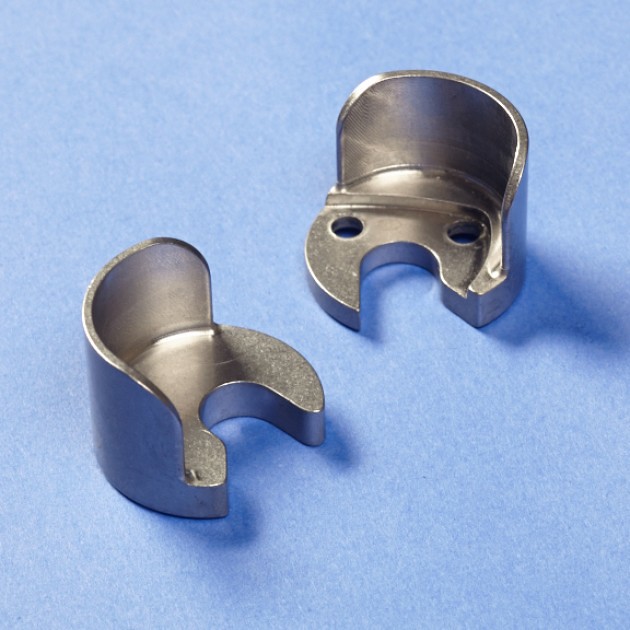
And just for reference again... the DM hanger that gets attached to the droputs... this is the mountain version. I've yet to see the road version but am anxious to see if it ultimately positions the derailleur where it's meant to be according to Shimano specs.

I suppose a framebuilder might vary from those specs, which is ok providing they know what and why they are doing that. For instance... if the builder knew in advance that a huge cassette would be standard fare on this bike, perhaps he might want to place the derailleur further back than normal to be able to access the large cogs at the expense of crisper shifting in the smaller cogs. And in the absence of the Shadow derialleur, I could see that, but I can't see that in this case, since by default a DM hanger dicatates that the Shimano Shadow derailleurs will be used, since they are the only ones spec'ing it. And Shimano has designed their derailleurs to accommodate those large cassettes, in the position that Shimano specs. What I'm having difficulty seeing in the pics that @pdlpshr1 has provided is exactly where the derailleur is ending up when the bike is dead level. It appears that it's too far back and too high, and I think there's more going on there than just the fact he has a DM mtn hanger instead of a DM road hanger. I'm not sure but I'm curious as to how this all plays out.
It's obvious there were some issues during the intial setup of the chainlength and B-screw adjustment, so hopefully we'll see everything rectified at the end of all this, or at least better than it was shown in those first few pics.
So in conclusion, I still can't think of anything I've talked about in this thread that needs revising.
I did do some measurements on a bike that did have some issues however. It seems that if the distance between the rear axle and the inner edge of the BB (or a bridge between the chainstays if there is one) is about 350mm or less, then there could be some issues. Well, let's call them annoyances instead. All in all however, I really do like how the new derailleur wraps the cogs and can handle super big cassettes at the same time. But I also don't think it's necessary for every manufacturer to start producing Direct Mount hangers for all their frames, since Shimano is providing a perfeclty fine adaptor called the B-link. And if manufacturers do start providing DM hangers, then that's ok, but they still have to provide regular hangers for those who want to run Campagnolo or SRAM. At least that's how it stands today.
Kudos to anyone who has followed this far. I think the majority of what I wanted to say to finish this off is now complete. Open for discussion, or we could just shut it down and pretend we don't understand the whole thing well enough to say anything different.
But lets take @pdlpshr1's new bike as an example of what I want to show. The dropouts on his bike look like they are also from Paragon. I suspect they are similar, or even idetntical, to the ones in the pic below. They are very versatile from a framebuilders point of view in that they provide a lot of surface area to attach chain and seatstays and they provide some latitude as to the positioning of things and the angles at which the stays come in at. You can rotate them to a certain extent, they're not inherently tied to an exact position. However, you can't ignore where the hanger is going to end up in the process as that is dictated by the two holes and cutout where the hanger will attach. It's easy to see if the dropout is rotated clockwise just a little bit, it swings the hanger backwards and up. Likewise, if it's rotated counterclockwise a bit, it's going to rotate the hanger forward and down. From a users point of view, I'm not fussed about them for a couple of reasons: 1) They generally prevent or make it hard to use the bike in many trainers should you want to, and 2)you can't close your skewers in between the chainstay and the seatstays, meaning your left to have your skewer levers either sticking out behind or below. Ugly.

And just for reference again... the DM hanger that gets attached to the droputs... this is the mountain version. I've yet to see the road version but am anxious to see if it ultimately positions the derailleur where it's meant to be according to Shimano specs.

I suppose a framebuilder might vary from those specs, which is ok providing they know what and why they are doing that. For instance... if the builder knew in advance that a huge cassette would be standard fare on this bike, perhaps he might want to place the derailleur further back than normal to be able to access the large cogs at the expense of crisper shifting in the smaller cogs. And in the absence of the Shadow derialleur, I could see that, but I can't see that in this case, since by default a DM hanger dicatates that the Shimano Shadow derailleurs will be used, since they are the only ones spec'ing it. And Shimano has designed their derailleurs to accommodate those large cassettes, in the position that Shimano specs. What I'm having difficulty seeing in the pics that @pdlpshr1 has provided is exactly where the derailleur is ending up when the bike is dead level. It appears that it's too far back and too high, and I think there's more going on there than just the fact he has a DM mtn hanger instead of a DM road hanger. I'm not sure but I'm curious as to how this all plays out.
It's obvious there were some issues during the intial setup of the chainlength and B-screw adjustment, so hopefully we'll see everything rectified at the end of all this, or at least better than it was shown in those first few pics.
So in conclusion, I still can't think of anything I've talked about in this thread that needs revising.
I did do some measurements on a bike that did have some issues however. It seems that if the distance between the rear axle and the inner edge of the BB (or a bridge between the chainstays if there is one) is about 350mm or less, then there could be some issues. Well, let's call them annoyances instead. All in all however, I really do like how the new derailleur wraps the cogs and can handle super big cassettes at the same time. But I also don't think it's necessary for every manufacturer to start producing Direct Mount hangers for all their frames, since Shimano is providing a perfeclty fine adaptor called the B-link. And if manufacturers do start providing DM hangers, then that's ok, but they still have to provide regular hangers for those who want to run Campagnolo or SRAM. At least that's how it stands today.
Kudos to anyone who has followed this far. I think the majority of what I wanted to say to finish this off is now complete. Open for discussion, or we could just shut it down and pretend we don't understand the whole thing well enough to say anything different.
Colnago C64 - The Naked Build; Colnago C60 - PR99; Trek Koppenberg - Where Emonda and Domane Meet;
Unlinked Builds (searchable): Colnago C59 - 5 Years Later; Trek Emonda SL Campagnolo SR; Special Colnago EPQ
Unlinked Builds (searchable): Colnago C59 - 5 Years Later; Trek Emonda SL Campagnolo SR; Special Colnago EPQ






